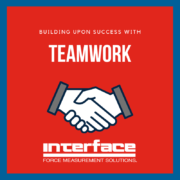Why Students Need to Learn About Force Measurement
 Understanding the intricacies of force measurement is essential for students planning careers in engineering, medical research, product design, technology, aerospace, metrology, and automation.
Understanding the intricacies of force measurement is essential for students planning careers in engineering, medical research, product design, technology, aerospace, metrology, and automation.
Test and measurement impact nearly every industry, from civil engineering to robotics. Research and development for various products, structures, machines, and components used in aerospace, automotive, healthcare and medical devices, infrastructure, maritime, energy, agriculture, and consumer products commonly use load cells and other sensor technologies.
Moreover, a solid grasp of force measurement empowers students to become innovators and problem-solvers in an increasingly technology-driven world. As industries evolve and new technologies emerge, the demand for individuals capable of understanding and applying force measurement principles will only grow.
By fostering a solid foundation in this area, students position themselves to contribute meaningfully to advancements in fields utilizing sensor technologies. The ability to design, analyze, and optimize systems that rely on force measurement will be invaluable as they navigate their professional journeys and seek to impact society positively.
Exploring Real-World Force Measurement Applications
Understanding force measurement is crucial for students as it forms the foundation of numerous real-world applications across various industries. From engineering and manufacturing to healthcare and transportation, the ability to accurately measure and control forces is paramount.
Thrust Measurement in Rocket Propulsion: In space exploration, precise thrust measurement is essential to ensure spacecraft and rockets’ successful launch and trajectory. Students learn about using load cells or force transducers to measure the thrust generated by rocket engines during testing and flight. This knowledge helps them understand the critical role of force measurement in optimizing rocket propulsion systems, achieving the required thrust levels for specific missions, and ensuring spacecraft reach their intended destinations safely and efficiently.
Load Cells in Engineering and Construction: Students may encounter load cells in engineering and construction projects. By studying how load cells measure the force exerted on bridges, buildings, and other structures, students learn about the critical role of force measurement in ensuring structural integrity and safety. They also gain insights into the different types of load cells used for various applications, such as compression load cells for measuring the weight of a building or tension load cells for monitoring the tension in cables.
Force Sensors in Robotics and Automation: In robotics and automation, force sensors enable robots to interact with their environment with precision and control. Students learn about the importance of force feedback in robotic arms for assembly, pick-and-place operations, and even delicate surgical procedures. By understanding how force sensors measure the interaction forces between a robot and its surroundings, students appreciate the complexities of force measurement in dynamic systems and its implications for robotic design and control.
Dynamometers in Automotive and Aerospace: The automotive and aerospace industries rely heavily on dynamometers to measure the force and torque produced by engines and other components. Students learn about the use of dynamometers in engine testing, performance evaluation, and vehicle development. Through hands-on experience or simulations, students understand how dynamometers measure the forces generated during different operating conditions, enabling them to grasp the importance of force measurement in optimizing vehicle performance, fuel efficiency, and safety.
Force measurement plays an integral role in designing safe and efficient structures, ensuring the precision of medical devices, or optimizing vehicle performance. By learning about force measurement, students gain valuable insights into the fundamental principles governing the physical world and equip themselves with the knowledge necessary to tackle complex challenges in their future careers. You can see hundreds of real-world applications here.
Understanding Force Measurement Capabilities
Load Cell 101: The invention of the load cell lies at the core of force measurement. A load cell sensor measures and converts force into an electrical signal. In test and measurement, the load is essentially a synonym for force, and the signal produced by a load cell is most commonly displayed in units of mass or torque. Read Load Cell 101
Strain Gage 101: A strain gage is at the heart and soul of every load cell. The sensor varies its resistance as it is stretched or compressed. When tension or compression is applied, the strain gage converts force, pressure, and weight into a change that can then be measured in electrical resistance. This pinnacle technology allows engineers to collect and analyze force data, known in the industry as force measurement. Read Strain Gages 101
Types of Force Measurement Testing 101: Engineers, product designers, manufacturers, and test labs perform distinct force tests to accurately measure factors that control quality, safety, and reliability. Testing force helps to qualify how something will react when applying load, either by a standard application or by pulling and pushing it fails. The type of force measurement classifications are compression, fracture, tension, flexure, and shear. There are variations to each test classification, such as cycle testing, which is often a subset of fatigue and mechanical strength tests. Hardness testing is frequently referred to as nondestructive testing. Initial R&D tests typically center around choosing materials, strength and durability tests, compression ergonomic and abrasion tests. Learn more in Types of Force Measurement Tests 101
Interface offers an entire Force Measurement 101 series that details many topics related to test and measurement. You can follow the 101 series here.
Load Cell Basics
It is crucial to understand how a load cell works, its components, and its applications. When selecting a load cell, it’s critical to understand the significant factors impacting sensor accuracy. These factors are determined by the materials and components used in the load cell construction, calibration, instrumentation, accessories such as cables, and mounting installation. Each must be considered in the specific use cases for the load cells.
An important consideration when selecting your load cell is the sensor specifications and how they impact accuracy. The four primary categories of specifications include:
- Mechanical – Dimensions and Mounting
- Electrical – Output and Excitation
- Environmental – Temperature and Moisture
- Performance – Accuracy and Thermals
Read Load Cell Sensor Specifications
Types of Load Cells
Load cells come in various configurations, each suited for specific applications. Interface has thousands of models with varying measurement capacities and types. For instance, bending beam cells are commonly used in platforms and conveyor belt scales due to their simplicity and robustness. On the other hand, shear beam cells are favored in applications requiring higher capacities and greater accuracy, such as industrial scales and material testing machines.
We manufacture different types of load cells and Interface Mini’s™ that have capacities of measurement pounds force ranging from less than one lbf (500 gf) to two million lbf (9,000 kN). The following load cell models are most frequently used in applications measuring force based on use case popularity. Each type offers distinct advantages and limitations, and selecting the suitable load cell for a particular application is a valuable skill.
- LowProfile Load Cell (Pancake)
- Miniature Beam Load Cell (MB)
- S-Type Load Cell
- Sealed Beam Load Cell
- Column Load Cell
- Rod End Load Cell
- Multi-Axis Load Cell
- Load Button Load Cell
- Load Washer Load Cell
- Single Point Load Cell
Force measurement is not just about applying a force for a single measurement. Data acquisition, analysis, control processes, and performance monitoring are all functions that utilize force measurement output. Understanding the different load cell types and their appropriate applications is vital for students. Higher education institutions worldwide often have testing labs using Interface force measurement products to help validate inventions and advance knowledge in the science of measurement.
Learning References for Force Measurement
The field of test and measurement is also continually evolving, with innovations that enhance the capabilities and applications of load cells. For example, wireless load cells and advanced data acquisition systems have expanded the possibilities for force measurement in remote and dynamic environments.
Staying abreast of these innovations is crucial for students and professionals alike. Test and measurement demands continuous learning and adaptation to new technologies and methodologies. Interface offers several resources to stay ahead of trends, topics, and use cases. Follow our blog and use our technical references. Here are just a few must-save resources:
Watch Interface Videos, Webinars and Applications (250+ Videos)
Stay Up-to-Date
How Load Cells are Used
Dig Deep Into Force Measurement
- Technical Library
- White Papers
- Load Cell Field Guide to download a free copy
- Case Studies
Test and measurement are at the intersection of many careers. Force measurement offers exciting opportunities to contribute to advancements in various industries by mastering the principles of load cells, testing options, and staying informed about technological innovations. We look forward to helping you best prepare for your learning journey and joining us as ForceLeaders.







